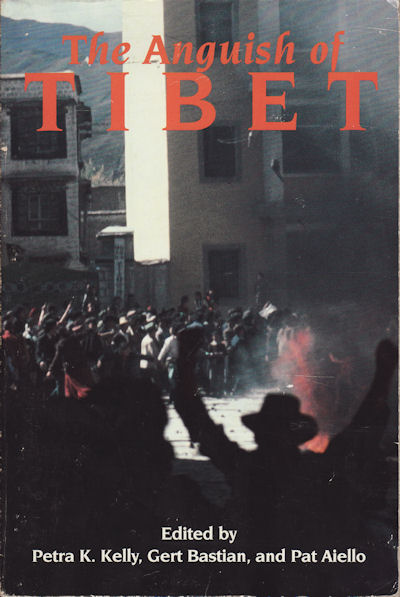The Anguish of Tibet
Edited by Petra K. Kelly, Gert Bastian, and Pat Aiello.
Parallax Press: Berkeley, 1991.
382 pp. $17.00.
Tibet may be in vogue in this International Year of Tibet, but the iron yoke of Chinese oppression continues unimpeded by world opinion. Despite the fact that the Dalai Lama received the Nobel Peace Prize in 1989, Tibet continues to be occupied by China and isolated from the global community. In fact, the Chinese government continues to dismiss its flagrant abuses of human rights in Tibet as a purely “domestic affair. “
The Anguish of Tibet is a frontal assault on the status quo and challenges the hands-off policy of the West based on an economic desire to keep the door open to a vast Chinese market. Editors Gert Bastian and Petra Kelly of the German Green Party and Pat Aiello of the International Campaign for Tibet have compiled the most comprehensive chronicle to date of China’s religious, cultural, and environmental desecration of Tibet. “Human rights are indivisible. Whenever, wherever, and by whomever they are violated, public condemnation by everyone with a voice to raise must be the reaction. Silence is a betrayal of those who are suffering. The aim of this book is to end this disgraceful silence,” Kelly and Bastian declare in their introduction.
Kelly has been hammering away for the past decade at the “great brick wall around the Tibetan issue” erected by German government and business interests. That official silence was broken in October of 1987 when the West German parliament unanimously passed a resolution condemning China’s human rights violations in Tibet after Chinese troops fired on crowds of peaceful demonstrators in Lhasa.
In April of 1989 the Greens organized a landmark international hearing on Tibet and human rights in Bonn. The editors have included compelling testimony of Tibetan refugees at the Bonn hearing. In her “Report from a Chinese Prison Camp” Mrs. Adhi, who spent twenty-eight of her fifty-six years in Chinese prison camps, gives a harrowing account of daily torture, shootings, forced labor, and starvation. Interviews with Tibetans in northern India who escaped from Chinese prisons following the riots of 1987 gave testimony of beatings, electric shock with cattle prods, and hanging by the extremities.
Blare Kerr, who led a medical expedition to Tibet, interviewed Tibetan women about Chinese practices of forced abortion and mass sterilizations. In “Tibetans under the Knife,” Kerr documents the apparent Chinese policy of genocide toward the Tibetan people, outnumbered in their homeland already by an influx of Chinese settlers.
Contributions by John Avedon, Hugh Richardson, and Orville Schell provide historical and political evidence for Tibet’s thousand-year-old claim to sovereignty: the Dalai Lama and Galen Rowell contrast the traditional Tibetan reverence for nature with China’s exploitation of Tibet’s vast mineral wealth, dense ancient forests, and slaughter of wildlife, all of which have created an environmental crisis on the Tibetan plateau. Other writers warn of China’s nuclear arsenal and plans for high-level nuclear-waste dumps on the Roof of the World.
The reader is left with a sense that time is running out for the Tibetan people and their homeland. Yet diplomatic efforts to gain the United Nations’ recognition for Tibetan self-determination as well as political initiatives, such as the Dalai Lama’s Five-Point Peace Plan, have kept alive the hope that Tibet may become a free land again. With the winds of liberation blowing from Eritrea to the Baltics, that hope may be more than a futile dream. The Anguish of Tibet is an invaluable resource for achieving that goal. It is not a coffee-table book with colorful photographs of an exotic Shangri-la for cocktail party pleasantries but an organizing tool to inform, outrage, and arouse readers to action. Nonetheless, leave it on the coffee table. It might prick someone’s conscience.
Thank you for subscribing to Tricycle! As a nonprofit, we depend on readers like you to keep Buddhist teachings and practices widely available.
